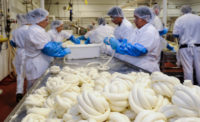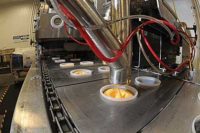At the end of the production lines, the freshly filled yogurt packages and beverages are assembled on pallets. Automated guided vehicles pick up the pallets and convey them to the cooling tunnels. The AGVs are guided by mirrors in the area.
The pallets are built to allow maximum air flow to speed cooling. From the tunnel, the product moves to a storage cooler that can accommodate approximately one day’s worth of production. Then the products are moved out to distribution centers in Dayton, Ohio, and Orefield, Pa. Other Dannon DCs are in Salt Lake City and Fort Worth, Texas.
Energy efficiency, employee safety
Form-fill-seal and the AGVs are examples of how Dannon uses automation for efficiencies in production and energy, as well as for safety.
“Our automation control of all processes is comprehensive and sets a new standard for operations and quality control,” Roy said.
A plant as large as the one in Minster requires a lot of heating, cooling, lighting and water. Dannon has installed high-efficiency compressors, pumps and boilers that vary their energy levels based upon the real-time demand of the facility, Roy said.
“Matching the creation of utilities with consumption on a real-time basis provides the optimum cost efficiency for the plant. We also do a lot of chemical recovery and water recovery through programming and monitoring devices during CIP,” he said.
Dannon has a goal of zero safety incidents. It follows traditional practices like lock-out/tag-out, communications and auditing. But the real key to reducing safety incidents to zero is to instill “a culture of peer-to-peer behavior-based safety,” said Roy, who worked in an automotive plant before joining Dannon. The culture is one in which “we are all looking out for one another’s safety,” he said.
Employees cannot escape the safety message. Outlines of footsteps leading to the production area mention safety. In the area where employees wash up before their shifts is a bulletin board titled “Why I’m Safe Every Day.” Employees have pinned photos of family members and others important to them. Another banner states, “Safety Begins With Me.”
Safety teams instruct employees on best practices in manufacturing. Video cameras on the production lines allow team members to observe work habits and behaviors that need correction, such as improper lifting techniques or reaching under or over equipment.
Elsewhere on the production floor, focus improvement teams analyze why things break, and how to minimize technical downtime. Measuring, analyzing and correcting help any business to improve and become more efficient. Dannon uses various metrics to gauge risk and measure efficiencies. For example, it tracks losses of milk and protein, which are valuable inputs for a yogurt processor.
Key indicators followed at Minster are:
- Safety (measurements include lost time, recordables and near misses)
- Quality (consumer comments, first-time quality, internal process conformance)
- Cost (product losses, line losses of packaging material, labor costs, energy use, chemical costs)
- Delivery (plant efficiency and product service level)
- Motivation (engagement, attendance, team involvement)
Dannon has no plans on slowing down. In the last year alone, it invested $88 million in this plant. This may create up to 100 new jobs in the area over three years. Dannon is also considering an expansion of cold storage and increasing storage space for packaging material. To keep up with the pace of change at Minster, there are project management teams dedicated solely to capital installations and other teams working on equipment commissioning. Teams focused on specific projects “can be highly successful when completely dedicated to this effort,” Roy said.
The barges and mules on the Miami and Erie Canal are long gone. The canal has been developed into a hiking trail. These days, refrigerated tractor trailers filled with Dannon products connect Minster to the rest of the world. The town’s founding fathers no doubt would be proud.









